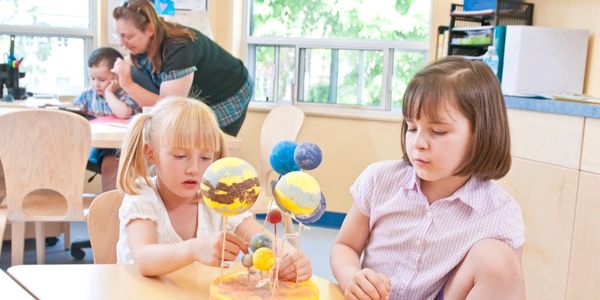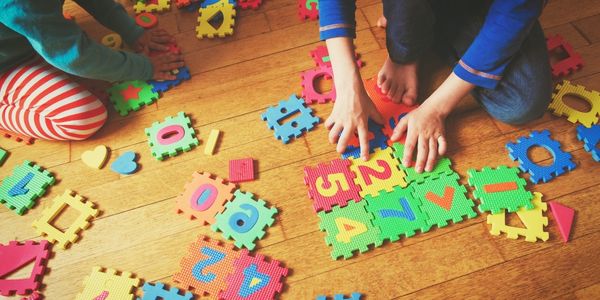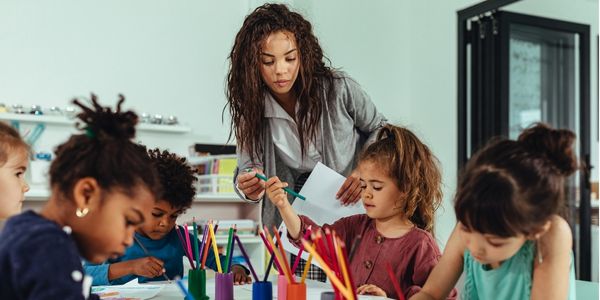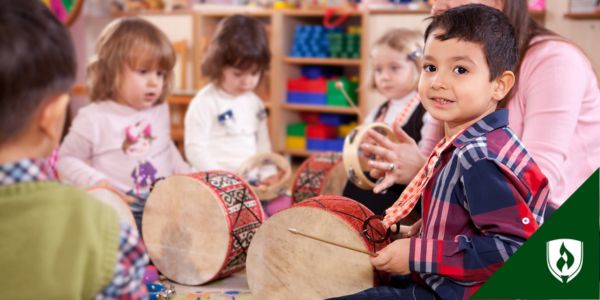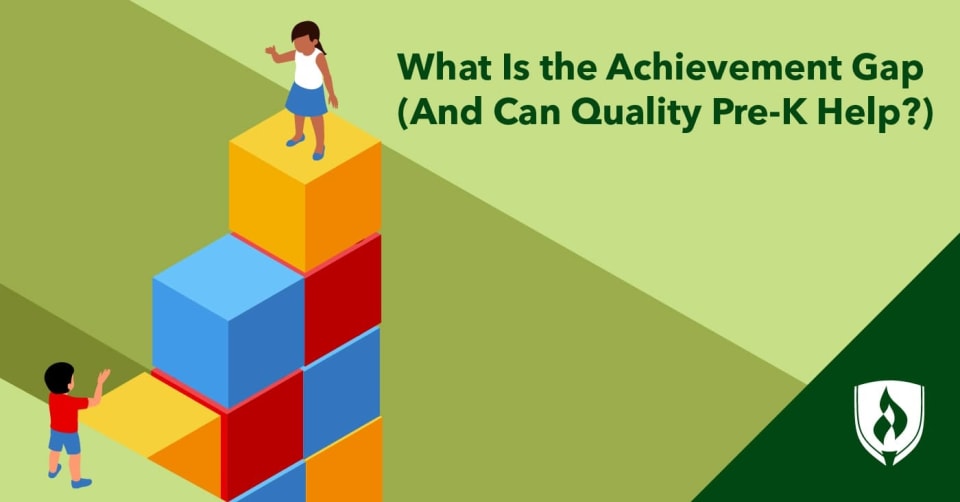
It’s well-established that there can be a lot of variance in educational outcomes for students across the country. Some school districts regularly produce high-achieving students who have several hours of college-level course credits to their name by graduation, while others have cause for celebration when fifty percent of the class is proficient at reading.
This stark difference in educational outcomes is sometimes referred to broadly as “the achievement gap.” Knowing this gap exists is a launching point for a lot of research and discussion on what can be done to close the achievement gap. While the solution to this problem is complex and likely to require a multi-pronged approach to be truly effective, promoting high-quality early childhood education is certainly in that mix.
In this article, we’ll dive further into the achievement gap, who it affects and how initiatives like providing universal pre-k can play a role in closing this gap.
What is the achievement gap?
According to the National Assessment of Educational Progress, an achievement gap occurs when “one group of students (e.g., students grouped by race/ethnicity, gender) outperforms another group, and the difference in average scores for the two groups is statistically significant.”1 While achievement differences between demographics are often in the spotlight, there can also be gaps between students with disabilities and those without, English language learners and native English speakers, and gaps between socioeconomic strata.
Evidence for the achievement gap is most commonly found in dropout rates, test scores, college enrollment rates and other measurements of success in schools. These gaps have persisted historically, and the turbulence of recent years likely isn’t helping. According to a McKinsey & Company® report, the educational disruptions caused by the COVID-19 pandemic, including online learning, school closures and teacher shortages, have also had an effect on test scores and other educational outcomes.2
“What I’m seeing in the past two years is that the four-year-old [children] I work with have had almost no social education,” says Rebecah Freeling, a child behavior expert and parent coach at Wits’ End Parenting®. Freeling shares that she’s noticed many of the basics of group socialization are lacking.
“Sharing, standing in a line, sitting and listening to a story, not fighting—kids are going into kindergarten without those skills,” she says.
Scott Winstead, founder of My eLearning World, argues development of these social skills is more important long-term for preschool-age children than focusing on learning academic facts.
“The primary role of preschool is to socialize young children and help them learn to function in a classroom,” Winstead says. “This, in turn, helps them be more successful when entering the elementary classroom.”
What’s driving the achievement gap?
So even when setting aside COVID-19 related difficulties, why do some students succeed while others struggle? And what do experts think is the best way to bridge the gap for good? Many of the experts we talked to say that it’s not about “achievement” as much as it’s about “opportunity.” Redefining how we perceive the so-called achievement gap is the first step to making concrete, lasting changes in education.
When it comes to affordable, accessible preschool, many families are unable to send their young children to programs that may enrich their language and social skills. Families under economic stress, whose children would certainly benefit from quality preschool experiences, are the most vulnerable.
“Options such as Montessori, Waldorf, Reggio Emilia, forest preschools or bilingual preschools may not be available,” says Dr. Ileana Hilton, founder of Seraphim Educational Consulting. “Or the hours of operation—half days, 9 a.m.–3 p.m.—are not conducive to working families. Therefore, lower- and middle-income families in the U.S. can only afford certain types of programs, many with poorly trained staff.”
The development of language skills that pre-K programs offer children are crucial to their future growth, says Whitney Rancourt, an elementary school teacher at a Title 1 campus and writer at Mama Manages.
“Quality pre-k can help close the achievement gap for low-income, at-risk students by immersing them in a language-rich environment,” Rancourt says. “There have been numerous studies that indicate a language deficit or advantage that correlates with socioeconomic status. Language shortfalls begin to appear as early as 18 months in children born to mothers with low socioeconomic status. By getting children in a pre-k environment as early as possible, we can start to close the achievement gaps that appear fairly soon after birth.”
Freeling sees the achievement gap as more properly understood as an “opportunity gap.” Quality pre-K offers children the opportunity to practice social skills, meet people who are different than them, try new activities, visit new places. Every play interaction, every experience outside, every new story read or conflict negotiated represents an opportunity for young children to practice being in not just a classroom but the larger world.
“In childhood, we decide who we are, but that identity is co-created,” Freeling explains. “Everyone we meet as children tells us who we are. The more people we meet, outside our families and our circle, who can tell us who we are, the better.”
Could universal pre-k education help close achievement gaps?
Changes to education policy like adopting universal pre-k are often discussed by those who seek to close achievement gaps. So how can they help?
Rancourt believes properly supported, high-quality universal pre-k programs are a viable way to combat the achievement gap.
“There is no doubt that a well-funded universal pre-k with reasonable class sizes of no more than 20 students, one teacher and one paraprofessional would have a huge positive impact on closing the achievement gap,” Rancourt says. “Currently, there are far too many stay-at-home mothers or single moms who can’t justify the expense of preschool when it cuts into a food and housing budget.”
Randi Wolfe, executive director of ECEPTS, also backs universal pre-k, stressing the need for proper professional preparation and pay for ECE staff.
“We must ensure that universal pre-k programs are consistently and reliably of high quality—which means play-based, culturally and community responsive, and developmentally appropriate,” Wolfe says. “And the key to making sure that happens is ensuring a high-quality ECE workforce of well-trained, well-compensated early care and education professionals.”
That said, many of the issues driving achievement disparities expand far beyond the scope of early education—systemic problems will likely need a multi-pronged approach to be effective.
“We’re going to have to also feed families. Offer welfare and food programs. Make sure parents are working and earning a living wage,” Freeling says. Quality preschool cannot make difficult family situations instantly better.
“You can recover from a bad childhood—people do it all the time,” Freeling says. “But wouldn’t it be nice if you didn’t have to?”
Positioning early childhood education programs for success
In an education landscape that is often hyper-focused on standardized testing scores and academic success, it may seem like the answer is to spend significant time drilling literacy and mathematics concepts into young pupils. While it certainly doesn’t hurt to introduce some fundamental concepts at a young age, some argue that emphasizing a narrow academic focus in early education may miss the mark.
Hilton believes that pre-k programs should not lose focus on building a solid behavioral foundation for young children.
“Strategies that enhance children’s ability to self-regulate prove more efficient to academic success than strategies that focus on educational content,” Hilton explains. “Socio-dramatic play, interactive book reading and conversations between teachers show positive effects on children’s self-regulation.”
In Freeling’s view, the solution to making classrooms more equitable and effective long-term is about more than just changing lesson plans or adopting any one educational philosophy.
“[In order to make progress,] we pay teachers well, we make sure we have a low student-to-teacher ratio, we have lots of active playtime, social skills-building, field trips. Living examples through real experiences, play and work,” Freeling says.
Teaching and impacting the future
Feeling up to the challenge of creating equitable school experiences for young children? Becoming an early childhood education (ECE) professional is one way to positively impact children in your community, as your work can set the stage for a lifetime of learning and healthy behavior. Learn more about why ECE is a virtual first step to closing the achievement gap in our article “5 Reasons Why the Importance of ECE Is Impossible to Ignore.”
1“Achievement Gaps” National Assessment of Educational Progress, National Center for Education Statistics, October 14, 2021, [accessed March 2022], https://nces.ed.gov/nationsreportcard/studies/gaps/.
2Emma Dorn, Bryan Hancock, Jimmy Sarakatsannis, and Ellen Viruleg, “COVID-19 and Education: An Emerging K-Shaped Recovery” McKinsey & Company, December 14, 2021, [accessed March 2022], https://www.mckinsey.com/industries/education/our-insights/covid-19-and-education-an-emerging-k-shaped-recovery
McKinsey & Company is a registered trademark of McKinsey Holdings, Inc.
Wits’ End Parenting is a registered trademark of Hope Rock House, Inc.
Editor’s Note: This article was originally published in 2018 and has since been updated.

